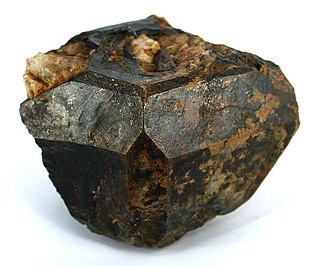 W
WBéhierite is a very rare mineral, a natural tantalum borate of the formula (Ta,Nb)BO4. Béhierite is also one of the most simple tantalum minerals. It contains simple tetrahedral borate anions, instead of more common among minerals, planar BO3 groups. It forms a solid solution with its niobium-analogue, schiavinatoite. Both have zircon-type structure (tetragonal, space group I41/amd) and are found in pegmatites. Béhierite and holtite are minerals with essential tantalum and boron.
 W
WBetafite is a mineral group in the pyrochlore supergroup, with the chemical formula (Ca,U)2(Ti,Nb,Ta)2O6(OH). Betafite typically occurs as a primary mineral in granite pegmatites, rarely in carbonatites. Defined by the B-site atom Ti, Atencio et al.(2010) combined and considered the ideas portrayed in (Hatert and Burke)(2008) and a modernization of (Hogarth)(1977) system for nomenclature of pyrochlore and betafite in order to further rationalize the naming process of this grouping of minerals. Therefore, Atencio et al. (2010), states that only two of the mineral species that were formerly recognized under the previous nomenclature system of betafite in Hogarth (1977) are now recognized. They are oxyuranobetafite and oxycalciobetafite. Now the term betafite is a synonym or varietal group name under the pyrochlore super group (Christy and Atencio 2013).
 W
WColtan is a dull black metallic ore from which are extracted the elements niobium and tantalum. The niobium-dominant mineral in coltan is columbite, and the tantalum-dominant mineral is the tantalite.
 W
WColtan is the colloquial name for the mineral columbite-tantalum ("col-tan"); it is sometimes incorrectly used as shorthand for tantalite, a metallic ore from which the very similar elements niobium, also known as columbium, and tantalum are extracted. In the early 21st century coltan mining was associated with human rights violations such as child labour, systematic exploitation of the population by governments or militant groups, exposure to toxic chemicals and other hazards as a result of lax environmental protection, and general safety laws and regulations.
 W
WColumbite, also called niobite, niobite-tantalite and columbate [(Fe, Mn)Nb2O6], is a black mineral group that is an ore of niobium. It has a submetallic luster and a high density and is a niobate of iron and manganese. This mineral group was first found in Haddam, Connecticut, in the United States. It forms a series with the tantalum-dominant analogue ferrotantalite and one with the manganese-dominant analogue manganocolumbite. The iron-rich member of the columbite group is ferrocolumbite. Some tin and tungsten may be present in the mineral. Yttrocolumbite is the yttrium-rich columbite with the formula (Y,U,Fe)(Nb,Ta)O4. It is a radioactive mineral found in Mozambique.
 W
WEuxenite or euxenite-(Y) is a brownish black mineral with a metallic luster.
 W
WMicrolite was once known as a pale-yellow, reddish-brown, or black isometric mineral composed of sodium calcium tantalum oxide with a small amount of fluorine (Na,Ca)2Ta2O6(O,OH,F). Today it is a name of a group of oxide minerals of a similar stoichiometry having tantalum prevailing over titanium and niobium. The microlite group belongs to a large pyrochlore supergroup that occurs in pegmatites and constitutes an ore of tantalum. It has a Mohs hardness of 5.5 and a variable specific gravity of 4.2 to 6.4. It occurs as disseminated microscopic subtranslucent to opaque octahedral crystals with a refractive index of 2.0 to 2.2. Microlite is also called djalmaite, but both names are now obsolete.
 W
WPolycrase or polycrase-(Y) is a black or brown metallic complex uranium yttrium oxide mineral with formula: (Y,Ca,Ce,U,Th)(Ti,Nb,Ta)2O6. It is amorphous. It has a Mohs hardness of 5 to 6 and a specific gravity of 5. It is radioactive due to its uranium content (around 6%). It occurs in granitic pegmatites.
 W
WSamarskite is a radioactive rare earth mineral series which includes samarskite-(Y) with formula: (YFe3+Fe2+U,Th,Ca)2(Nb,Ta)2O8 and samarskite-(Yb) with formula (YbFe3+)2(Nb,Ta)2O8. The formula for samarskite-(Y) is also given as: (Y,Fe3+,U)(Nb,Ta)O4.
 W
WSimpsonite has a general formula of Al4(Ta,Nb)3O13(OH). It occurs as euhedral to subhedral tabular to short and prismatic crystals, commonly in subparallel groups. Under the petrographic microscope it has a very high relief.
 W
WStibiotantalite is a mineral consisting of Sb(Ta,Nb)O4 (antimony, tantalum or niobium, and oxygen). It is found in complex granite pegmatites.
 W
WThe mineral group tantalite [(Fe, Mn)Ta2O6] is the primary source of the chemical element tantalum. It is chemically similar to columbite, and the two are often grouped together as a semi-singular mineral called coltan or "columbite-tantalite" in many mineral guides. However, tantalite has a much greater specific gravity than columbite (8.0+ compared to columbite's 5.2). Iron-rich tantalite is the mineral tantalite-(Fe) or ferrotantalite and manganese-rich is tantalite-(Mn) or manganotantalite.
 W
WTapiolite [(Fe, Mn)(Nb, Ta)2O6] is a black mineral series that is an ore of niobium and tantalum. The tapiolite group includes tapiolite-(Fe) or ferrotapiolite and tapiolite-(Mn) or manganotapiolite. Tapiolite-(Fe) is by far the more common of the two.
 W
WTitanowodginite is a mineral with the chemical formula MnTiTa2O8. Titanowodginite has a Mohs hardness of 5.5 and a vitreous luster. It is an iridescent dark brown to black crystal that commonly forms in a matrix of smoky quartz or white beryl in a complex zoned pegmatite.
 W
WWodginite is a manganese, tin, tantalum oxide mineral with formula Mn2+(Sn,Ta)Ta2O8. It may include significant niobium.
 W
WZimbabweite is a mineral; formula (Na,K)2PbAs4(Nb,Ta,Ti)4O18. It is generally classed as an arsenite but is notable for also containing niobium and tantalum. A yellow brown mineral with orthorhombic crystal habit and a hardness of 5. It was discovered in 1986 in kaolinized pegmatite, i.e. weathered to clay, in Zimbabwe.